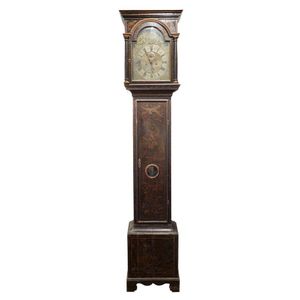George III Mahogany Longcase Clock by John Tickell, Crediton
You must be a subscriber, and be logged in to view price and dealer details.
Subscribe Now to view actual auction price for this item
When you subscribe, you have the option of setting the currency in which to display prices to $Au, $US, $NZ or Stg.
- Moon Dial - If we imagine life in the 17th century, the only source of ascertaining the time of day or night would have been the local church or municipal clock striking every quarter hour, and able to be heard by all in the village. In England, when longcase clocks became popular and more affordable in the late 17th century, the function of timekeeping and source of time was moved to within the home.
An additional feature on some longcase clocks was to display the phases of the moon, that is the new moon, the full moon and the waning moon over the lunar 29 ½ day cycle. This information was important for farmers for working out cropping schedules; for travellers to know the amount of moonlight on a night they planned to travel; and for those who lived near the sea required knowledge of the tides.
Where included, the moon dial is usually in the form of a disc incorporated into the main dial plate, usually in the arched top section. The lunar cycle starts with the new moon displaying, which is a dark night sky and no man-in-the-moon face being displayed, and then progresses to the full moon face showing on the 15th day of the lunar cycle, and back to no face displaying as the moon wanes. Most lunar dials are partially concealed on each side of their opening in the main dial plate by semi-circular "humps" that allow the painted face to emerge slowly just as the real moon goes out of and back into the earth's shadow.
Nowadays, details of the lunar cycle is published in diaries, almanacs, and newspapers and although some modern longcase clocks are still manufactured with working moon dials, they are more for decoration than for use. - George Iii - George III (1738 - 1820) was King of Great Britain and Ireland from 1760 to 1820.
- Anchor Escapement - An anchor escapement is a type of mechanical escapement used in clocks and watches. It is a refinement of the older verge escapement, which was used in early mechanical timekeeping devices. The anchor escapement is characterised by the use of an anchor-shaped pallet that rocks back and forth, alternately locking and releasing the escape wheel. This action allows the movement of the watch or clock to be regulated, producing the characteristic tick-tock sound that is associated with mechanical timekeeping devices. The anchor escapement is generally more accurate and reliable than the verge escapement, and it is still used in many modern clocks and watches today.
- Mahogany - Mahogany is a dense, close grained red-coloured timber from the West Indies and Central America. It was first imported into Europe in the the early 18th century and its use continued through the 19th century. It was popular for furniture making because of its strength, the wide boards available, the distinctive grain on some boards, termed flame mahogany and the rich warm colour of the timber when it was polished.. The "flame" was produced where a limb grew out from the trunk of the tree, and this timber was usually sliced into veneers for feature panels on doors, backs and cornices.
Some terms used to describe mahogany relate to the country from which it originally came, such as "Cuban" mahogany, "Honduras" mahogany etc. However unless the wood has been tested the names assigned are more a selling feature, rather than a true indication of the timber's origin.
This item has been included into following indexes:
Visually similar items

A George II Chinoiserie black Japanned longcase clock, circa 1750 decorated overall with Chinoiserie landscapes, 45 cm wide, 23 cm deep, 230 cm high

A George III mahogany longcase clock, the dial signed William Lee, Leicester the brass Roman numeral dial with subsidiary seconds dial and calendar, housing an anchor escapement on one bell, 223.5 cm high

An impressive c.1900 English Maple & Co. Ltd, London, complicated striking grandfather clock, the ornate oak case carved in the Jacobean manner with a classical woman figure, masks, urns, scrolls and pillars to the door, the engraved silvered dial with Rom

A 19th century mahogany cased long case clock with a painted Roman numeral moon phase dial, subsidiary seconds dial and calendar, the eight day bell striking movement with an anchor escapement housed in a break arch hood, the shaped rectangular casement do
